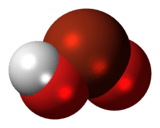Bromous acid
 | |
 | |
| Names | |
|---|---|
| IUPAC names
hydroxy-λ3-bromanone hydroxidooxidobromine bromous acid | |
| Identifiers | |
| 37691-27-3 | |
| 3D model (Jmol) | Interactive image |
| ChEBI | CHEBI:29247 |
| ChemSpider | 145144 |
| PubChem | 165616 |
| |
| |
| Properties | |
| HBrO2 | |
| Molar mass | 112.911 g/mol |
| Related compounds | |
| Other anions |
Hydrobromic acid; hypobromous acid; bromic acid; perbromic acid |
| Except where otherwise noted, data are given for materials in their standard state (at 25 °C [77 °F], 100 kPa). | |
| | |
| Infobox references | |
Bromous acid is an acid with the formula HBrO2. It has bromine in the +3 oxidation state. The salts of bromous acid are called bromites. The acid is not stable and only occurs as an intermediate; for example, in the oxidation of hypobromites.[1]
Chemistry
Bromous acid can be produced by classical chemical or electrochemicals method via anodic oxidation.
- HBrO + HClO → HBrO2 + HCl
Also disproportioning of hypobromous acid will give bromous acid and hydrobromic acid.
- 2 HBrO → HBrO2 + HBr
Lastly, a synproportion reaction of bromic acid and hydrobromic acid gives bromous acid.
- 2 HBrO3 + HBr → 3 HBrO2
Compounds
Several bromites are stable and have been isolated. For example, NaBrO2· 3H2O and Ba(BrO2)2·H2O.[1]
Use
Bromites can be used for the reduction of permanganates to manganates.[1]
- 2MnO−
4 + BrO−
2 + OH− → 2MnO2−
4 + BrO−
3 + H2O
References
This article is issued from Wikipedia - version of the 6/17/2016. The text is available under the Creative Commons Attribution/Share Alike but additional terms may apply for the media files.